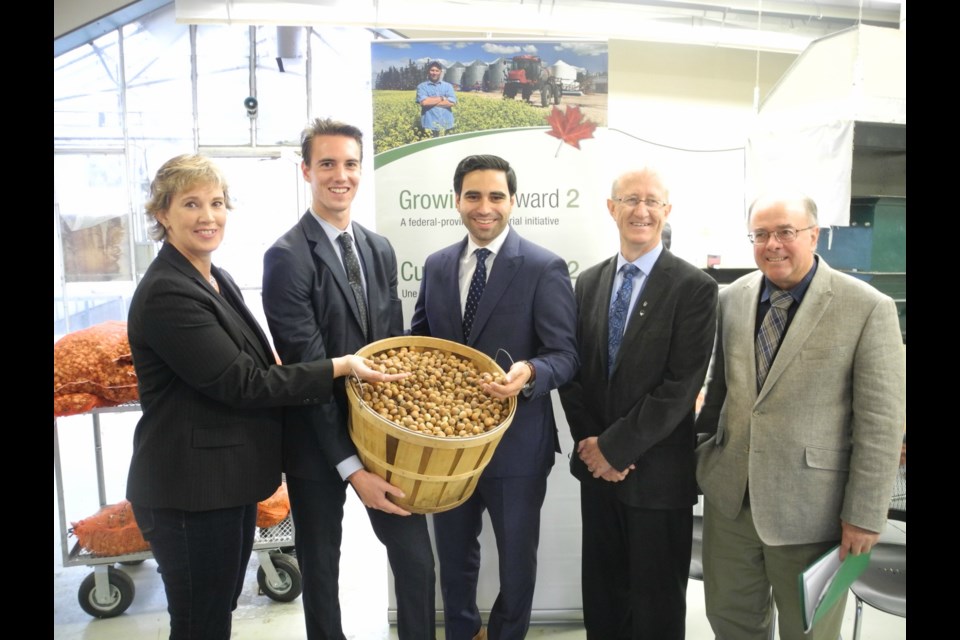Across Canada, the agri-food sector is well-served when Ottawa invests research money anywhere, and partnerships develop.
Partnerships are how new developments occur, and how things get done.
Lately, the University of Guelph and its partners have been the recipient of a great deal of that investment. The most recent example is the nearly $500,000 the federal government dedicated to further developing a hazelnut industry in Ontario, announced Wednesday.
This partnership involves the university, the Ontario Hazelnut Association, and Ferrero Canada. It’s been percolating for years, during which time the university worked with Ferrero to determine whether hazelnuts could indeed be grown in Ontario.
That research panned out, as did Ferrero’s growing interest in getting behind a hazelnut industry here. Now, with support from Ottawa, the partners will take the sector’s development one step further, pursuing matters such as drought stress in nursery trees, and establishing production techniques to multiply hazelnut plants for commercial use.
The hazelnut association has big plans. It wants to see 10,000 hectares of hazelnut trees growing in Ontario in 10 years. Association president Linda Grimo says the crop creates new economic opportunities for rural communities.
And she’s right. Ontario farmers grow millions of acres of corn and soybeans in Ontario. By comparison, the acreage of this specialty crop is small. But crops such as hazelnuts and others like it that are closely aligned with a company producing high value-added products are unique, and valuable.
Ontario farmers are increasing experimenting with new crops, citing market opportunities and diversification as their primary reasons. And if they’re going to see those opportunities flourish, the crops need a commitment to research, like the one hazelnuts are getting here.
Ottawa also took a giant step earlier this week in supporting agricultural technology and product evolution when it got behind what are called “superclusters” of research expertise, centred in western Canada.
Federal innovation minister Navdeep Bains calls superclusters job-creating regions with strong economies, like Silicon Valley in California. The Liberal government intends to spend $950 million creating five of them in Canada. It’s now announced its short list of nine.
The two superclusters related to agriculture and food are a protein innovations supercluster, intended to position Canada as the global supplier of plant-based proteins and related products. It’s led by Ag-West Bio Inc. and includes the University of Saskatchewan. The other is a “smart” agri-food supercluster led by Agrium Inc., which would work on precision technologies in crops, livestock and agri-food processing.
The winners will be announced in early 2018. Given the importance of partnerships and national focus on these projects, expect to see existing players reach out to more potential participants, to strengthen their case.
That could be for great news for agriculture, and for our region, especially considering another supercluster that made the short list is dedicated to advanced manufacturing. It involves Linamar Corp., Maple Leaf Foods, MaRs Discovery District and the University of Waterloo.
These are exciting possibilities. The decades-long research agreement between the Ontario Ministry of Agriculture, Food and Rural Affairs, and the University of Guelph is credited with returning $1.15 billion to the Ontario economy every year. It’s a unique and enviable partnership among all governments and universities in Canada, committed to safe food, disease monitoring and prevention, and new products and technology. It works, and it’s vitally important.
Some big challenges lie ahead for agriculture. Tax reform is looming federally and changes to the minimum wage have farmers reeling. They’re mounting campaigns against both these matters.
But as an industry, Canadian agriculture is strong. For example, farm cash receipts that have risen by an impressive $19 billion over the last decade.
J.P. Gervais, chief agricultural economist for Farm Credit Canada, the country’s biggest farm lender, says the industry has a firm foundation to face higher borrowing costs, which seem inevitable at some point in 2018.
The country needs sound, viable farms to grow the new crops that research supports and industry delivers to consumers.
That’s the most basic and important partnership of all.
